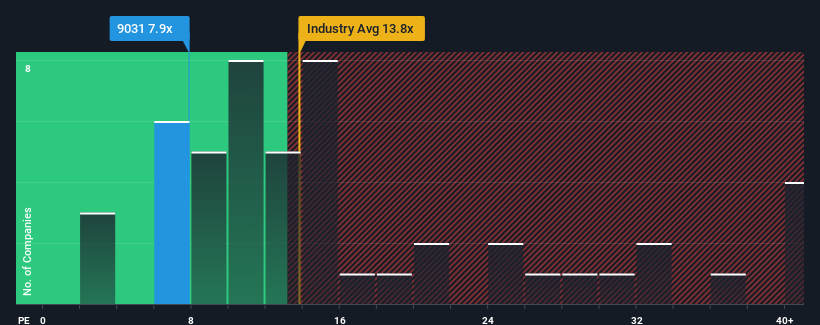- Japan
- /
- Transportation
- /
- TSE:9031
The Market Doesn't Like What It Sees From Nishi-Nippon Railroad Co., Ltd.'s (TSE:9031) Earnings Yet
When close to half the companies in Japan have price-to-earnings ratios (or "P/E's") above 15x, you may consider Nishi-Nippon Railroad Co., Ltd. (TSE:9031) as an attractive investment with its 7.9x P/E ratio. Although, it's not wise to just take the P/E at face value as there may be an explanation why it's limited.
Nishi-Nippon Railroad certainly has been doing a good job lately as it's been growing earnings more than most other companies. It might be that many expect the strong earnings performance to degrade substantially, which has repressed the P/E. If not, then existing shareholders have reason to be quite optimistic about the future direction of the share price.
Check out our latest analysis for Nishi-Nippon Railroad

Is There Any Growth For Nishi-Nippon Railroad?
The only time you'd be truly comfortable seeing a P/E as low as Nishi-Nippon Railroad's is when the company's growth is on track to lag the market.
If we review the last year of earnings growth, the company posted a terrific increase of 35%. However, the latest three year period hasn't been as great in aggregate as it didn't manage to provide any growth at all. Therefore, it's fair to say that earnings growth has been inconsistent recently for the company.
Looking ahead now, EPS is anticipated to slump, contracting by 9.4% per year during the coming three years according to the two analysts following the company. With the market predicted to deliver 9.6% growth per year, that's a disappointing outcome.
In light of this, it's understandable that Nishi-Nippon Railroad's P/E would sit below the majority of other companies. Nonetheless, there's no guarantee the P/E has reached a floor yet with earnings going in reverse. Even just maintaining these prices could be difficult to achieve as the weak outlook is weighing down the shares.
The Bottom Line On Nishi-Nippon Railroad's P/E
Generally, our preference is to limit the use of the price-to-earnings ratio to establishing what the market thinks about the overall health of a company.
We've established that Nishi-Nippon Railroad maintains its low P/E on the weakness of its forecast for sliding earnings, as expected. Right now shareholders are accepting the low P/E as they concede future earnings probably won't provide any pleasant surprises. Unless these conditions improve, they will continue to form a barrier for the share price around these levels.
It's always necessary to consider the ever-present spectre of investment risk. We've identified 3 warning signs with Nishi-Nippon Railroad (at least 2 which are concerning), and understanding these should be part of your investment process.
Of course, you might also be able to find a better stock than Nishi-Nippon Railroad. So you may wish to see this free collection of other companies that have reasonable P/E ratios and have grown earnings strongly.
Valuation is complex, but we're here to simplify it.
Discover if Nishi-Nippon Railroad might be undervalued or overvalued with our detailed analysis, featuring fair value estimates, potential risks, dividends, insider trades, and its financial condition.
Access Free AnalysisHave feedback on this article? Concerned about the content? Get in touch with us directly. Alternatively, email editorial-team (at) simplywallst.com.
This article by Simply Wall St is general in nature. We provide commentary based on historical data and analyst forecasts only using an unbiased methodology and our articles are not intended to be financial advice. It does not constitute a recommendation to buy or sell any stock, and does not take account of your objectives, or your financial situation. We aim to bring you long-term focused analysis driven by fundamental data. Note that our analysis may not factor in the latest price-sensitive company announcements or qualitative material. Simply Wall St has no position in any stocks mentioned.
Have feedback on this article? Concerned about the content? Get in touch with us directly. Alternatively, email editorial-team@simplywallst.com
About TSE:9031
Nishi-Nippon Railroad
Engages in the transportation business in Japan and internationally.
Slight risk and fair value.
Market Insights
Community Narratives



